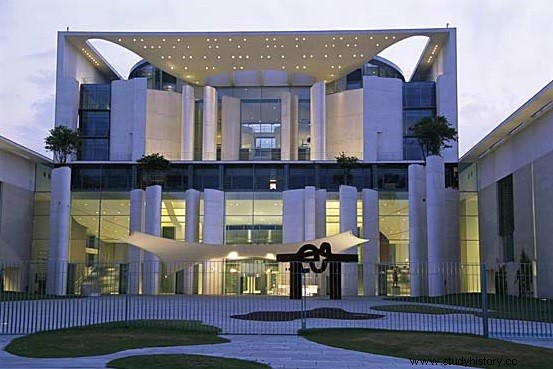 You take a trip to Berlin ? You don't have much time to devote to sightseeing but you still want to see "the main thing"? History for All recommends a route allowing you to go from the famous Alexanderplatz to the famous Checkpoint Charlie, passing in front of the prestigious Humboldt University, under the Brandenburg Gate and without forgetting the inevitable Reichstag. Also discover lesser known but equally important monuments. This pleasant walking tour is about 6 km long and lasts 1
h
30 to 2
h
for the rapids and an indefinite duration for the curious who will stop and read the many historical and explanatory panels. Berlin is indeed a city steeped in history.
You take a trip to Berlin ? You don't have much time to devote to sightseeing but you still want to see "the main thing"? History for All recommends a route allowing you to go from the famous Alexanderplatz to the famous Checkpoint Charlie, passing in front of the prestigious Humboldt University, under the Brandenburg Gate and without forgetting the inevitable Reichstag. Also discover lesser known but equally important monuments. This pleasant walking tour is about 6 km long and lasts 1
h
30 to 2
h
for the rapids and an indefinite duration for the curious who will stop and read the many historical and explanatory panels. Berlin is indeed a city steeped in history.
From Alex to Unter den Linden
From Alexanderplatz you can admire the famous Television Tower (Fernsehturm) which culminates at 368 meters high. Symbol of East Berlin, it was built from 1965 to 1969 and inaugurated by the then head of state of the GDR, Walter Ulbricht. Then head east towards the "red town hall", the town hall (Berliner Rathaus). From here you can take a short detour walking straight to the picturesque Nikolaiviertel to dive into a medieval Berlin with narrow and cobbled streets and admire the pretty facades of the buildings. Then walk to “Museum Island (Museuminsel). You will pass a bridge that crosses the Spree, on your left, a large green space where the Berliner Stadtschloss, the main residence of the princes of Hohenzollern, was once located. Heavily damaged during the Second World War, it was destroyed in 1950 by order of Walter Ulbricht who decided to remove this symbol of ancient Prussia.
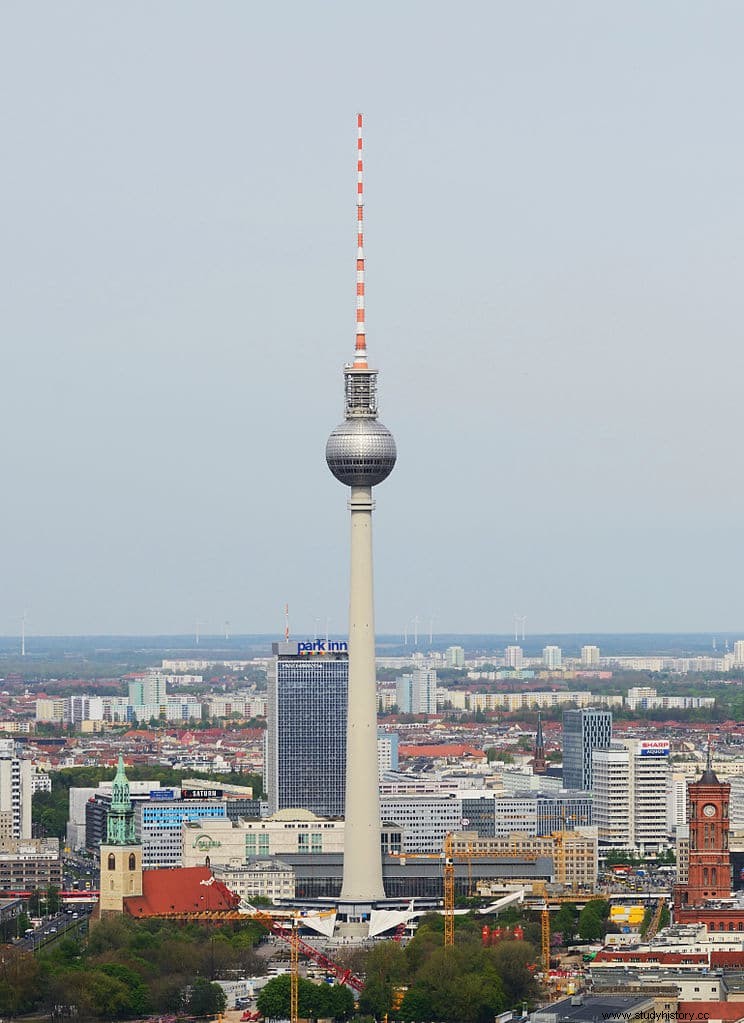 On your right is the Lustgarten , a large square where tourists and students like to relax on the green spaces. Very popular with the Nazis for the place it offers, they made many speeches here. You will also see the Berlin Cathedral (Berliner Dom) and the old museum (Altes Museum ). As you approach, you will see the many bullet holes and other shrapnel from the Second World War that dot the facades.
On your right is the Lustgarten , a large square where tourists and students like to relax on the green spaces. Very popular with the Nazis for the place it offers, they made many speeches here. You will also see the Berlin Cathedral (Berliner Dom) and the old museum (Altes Museum ). As you approach, you will see the many bullet holes and other shrapnel from the Second World War that dot the facades.
Unter den Linden and the Brandenburg Gate
Continue towards the Brandenburg Gate, you are now walking on the famous avenue Unter den Linden . On your right, the New Guard (Neue Wache), a work considered a masterpiece of German classicism, it was transformed into a monument dedicated to the victims of fascism and militarism by the East German authorities in 1960. You then pass in front of the historical museum on your right and the former palace of the crown prince (Kronprinz) on your left (building under renovation in 2011). A little further on, the prestigious Humboldt University (Humboldt Universität zu Berlin) founded in 1809.
It was here that many personalities such as A. Einstein, H. Heine, O. von Bismarck or even K. Marx! It faces the Faculty of Law, a building erected in the shape of a scale, symbolizing Justice, when viewed from an aerial view. The square in front of it is called the Bebelplatz and was the site of the Nazi burning of May 10, 1933. Students burned around 20,000 books that day deemed “unGerman” by Nazi authorities. The works of K. Marx, S. Freud, B. Brecht or E. M. Remarque were thrown into the flames and accompanied by the cheers of the students. Today, a monument recalls this painful memory, it is the "Sunken Library" by Micha Ullman.
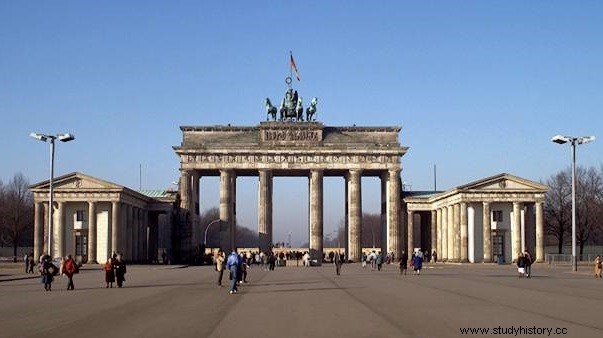
From the Reichstag to Potsdamer Platz via the Tiergarten
From the Brandenburg Gate, you can see the Reichstag on the right. Note the cobbled strip that winds down the middle of the road and symbolizes the former route of the Berlin Wall. The Reichstag , it is also a strong symbol for Germany. Seat of the German parliamentary assembly (Bundestag) since the reunification of 1990, the reconstruction of its glass dome destroyed in 1945 was an architectural challenge for Sir Norman Foster. Indeed, it is designed in such a way that the room of the deputies, located below, is flooded with natural light. Likewise, it is "lined" with solar panels that tilt automatically following the sun in order to best capture its light and thus ensure more than 80% of the building's electricity consumption.
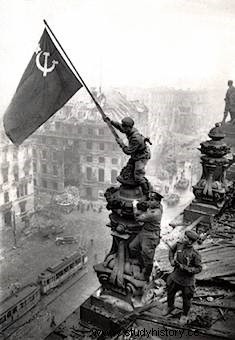 Although the war was not quite over, the capture of the Reichstag on April 30/ 1
er
May 1945 by the Russians is one of the strong symbols of the fall of the III
th
Reich. The famous photo showing a Soviet soldier raising the flag on the roof is a replayed scene and the soldier is a Georgian, carefully chosen to honor Stalin's origins. To our knowledge, there is no original photo of the hoisting of the flag but various testimonies indicate that it was not as beautiful because it was torn in many places. He too had suffered the horrors of the war.
Although the war was not quite over, the capture of the Reichstag on April 30/ 1
er
May 1945 by the Russians is one of the strong symbols of the fall of the III
th
Reich. The famous photo showing a Soviet soldier raising the flag on the roof is a replayed scene and the soldier is a Georgian, carefully chosen to honor Stalin's origins. To our knowledge, there is no original photo of the hoisting of the flag but various testimonies indicate that it was not as beautiful because it was torn in many places. He too had suffered the horrors of the war.
Retrace your steps, pass the Brandenburg Gate and head south on Ebertstrasse . On your left, the Memorial dedicated to the Jews murdered in Europe (Denkmal für die ermordeten Juden Europas) designed by Peter Eisenmann and inaugurated in 2004. It is a field covered with stelae arranged in a tight mesh. The stelae have the same length/width dimensions but not the same height. In addition, the land is not flat, it forms a kind of wave. The architect wanted to give an impression of "seasickness", that one is an impression of crushing, of claustrophobia. The narrow aisles are made in such a way that the visitor finds himself alone with himself, with his reflections, thus prohibiting group visits. Only the documentation center located below allows group visits and conferences.
Find the "surface", take the Hannah-Ar endt Strasse and join Gertrud-Kolmar Strasse . Continuing on this street and at the corner of In den Ministergarten you come across a sign indicating the location of Hitler's former bunker , where he killed himself on April 30, 1945. To prevent any possible Nazi pilgrimage, the bunker was razed and turned into a parking lot. Also, no Berlin tourist guide mentions its location…
From there, we can retrace our steps and find Ebertstrasse which runs alongside the Memorial to the Murdered Jews. A little hidden by the vegetation, you can also go to the Tiergarten , a 210-hectare park, a veritable "lung of Berlin", to see a stele which has the shape of a concrete bunker and which in fact houses a monument dedicated to the homosexual victims of Nazism . A small skylight lets you peek inside this concrete block. Here we let the visitor discover what is inside.
From Potsdamer Platz to Checkpoint Charlie
Now we come to Postdamer Platz , one of the CBD of Berlin (Central Business District or business center, in geographical language). Very modern district with contemporary buildings bordered by luxury hotels, it is new and came out of the ground after 1990! Indeed, the no man’s land of the Berlin Wall ran right through the middle of the square. Today, nothing suggests this painful past, except for the cobbled strip in the middle of the road, the meaning of which we have already mentioned. We will then head to the Sony Center to admire the glass and steel dome which has the particularity of resting in balance on the roof of the surrounding buildings. Attracting tens of thousands of visitors daily, this square is one of Berlin's must-see places.
Now let's dive back into Berlin's Nazi past. Let's take the direction of the topography of Terror (Topography of Terrors) to arrive at the site of the former headquarters of the Nazi organizations (SS and Gestapo) on the former Prinz-Albrecht-Strasse, the mere mention of which caused dread. The ruined buildings were razed after the war and today it is Niederkirchnerstrasse . Also in remembrance, a piece of the Berlin Wall was left in place. The outdoor (and free) exhibition traces the rise of the Nazi regime and the crimes perpetrated by it. A center was built on site and houses a permanent exhibit giving further information and details about the site and Nazi policies of persecution and extermination.
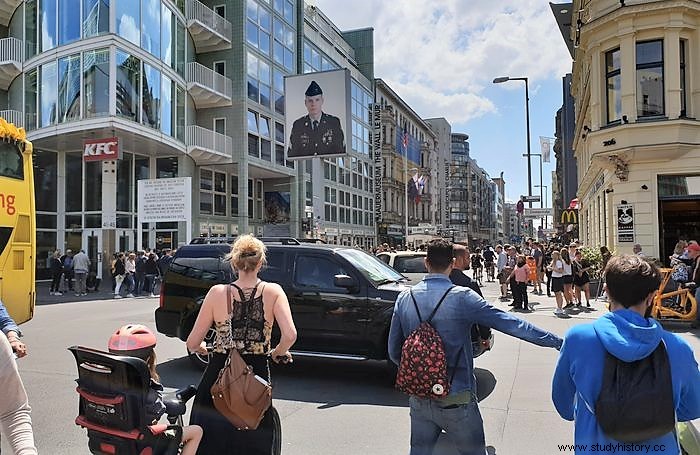 Go straight on Zimmerstrasse to reach the end of our visit:the famous Checkpoint Charlie , at the intersection with Kochstrasse . Checkpoint Charlie is a border post that separated the districts of Mitte and Kreuzberg then respectively under Russian and American control from the capital divided between the victors since 1945. The name was not chosen in reference to something or to some event. particular, it's just the code name for the letter "C" of military parlance. Checkpoint Alpha being a crossing point between Lower Saxony and Saxony-Anhalt and Checkpoint Bravo between Brandenburg and the city/Land of Berlin. The immediate environment at substation Charlie has changed since reunification. Indeed, the Russians had erected watchtowers and concrete corridors and chicanes to limit the speed of vehicles. This place was also the scene of many daring escapes of people hidden in the most improbable caches of vehicles and was the very symbol of the Cold War, the two superpowers facing each other directly. The Checkpoint Museum is located next door. It traces the evolution of the construction of the Berlin Wall, devotes a room to the most spectacular escapes and houses the original gatehouse.
Go straight on Zimmerstrasse to reach the end of our visit:the famous Checkpoint Charlie , at the intersection with Kochstrasse . Checkpoint Charlie is a border post that separated the districts of Mitte and Kreuzberg then respectively under Russian and American control from the capital divided between the victors since 1945. The name was not chosen in reference to something or to some event. particular, it's just the code name for the letter "C" of military parlance. Checkpoint Alpha being a crossing point between Lower Saxony and Saxony-Anhalt and Checkpoint Bravo between Brandenburg and the city/Land of Berlin. The immediate environment at substation Charlie has changed since reunification. Indeed, the Russians had erected watchtowers and concrete corridors and chicanes to limit the speed of vehicles. This place was also the scene of many daring escapes of people hidden in the most improbable caches of vehicles and was the very symbol of the Cold War, the two superpowers facing each other directly. The Checkpoint Museum is located next door. It traces the evolution of the construction of the Berlin Wall, devotes a room to the most spectacular escapes and houses the original gatehouse. Our Berlin "journey" ends here. As can be seen on the attached route map, most of the monuments are concentrated in the Mitte part. (central district) of Berlin. However, it should not be thought that this is "all" there is to see. Berlin is a very wealthy city in every way. Architecturally, culturally, historically… At the risk of repeating ourselves, we have recommended here a walking route for visitors who do not have much time to devote to tourism but which has the advantage of bringing together the main Sehenswürdigkeiten (curiosities).
To go further
- DÖBLIN, Alfred, Berlin Alexanderplatz, Paris, Gallimard, 2009. (novel retracing the life of a petty criminal, describes life in Berlin in the 1930s, atmosphere warranty)
- DROZ, Jacques, History of Germany, Paris, PUF, 2003.
- OUDIN, Bernard, GEORGES, Michèle, Histoires de Berlin, Paris, Perrin, 2010.
